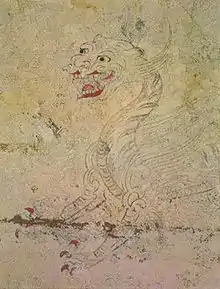White Tiger (mythology)
The White Tiger (Chinese: 白虎; pinyin: Báihǔ), known in Chinese as Baihu, is one of the Four Symbols of the Chinese constellations. It is sometimes called the White Tiger of the West (西方白虎; Xīfāng Báihǔ). It represents the west in terms of direction and the autumn season.

| White Tiger | |||||||||||||||||
|---|---|---|---|---|---|---|---|---|---|---|---|---|---|---|---|---|---|
 Bái Hǔ sculpture on an eaves tile | |||||||||||||||||
| Chinese name | |||||||||||||||||
| Chinese | 白虎 | ||||||||||||||||
| |||||||||||||||||
| Korean name | |||||||||||||||||
| Hangul | 백호 | ||||||||||||||||
| Hanja | 白虎 | ||||||||||||||||
| |||||||||||||||||
Seven Mansions
As with the other three Symbols, there are seven astrological "Mansions" (positions of the Moon) within the White Tiger. The names and determinative stars are:[1][2]
| Mansion no. | Name (pinyin) | Translation | Determinative star |
|---|---|---|---|
| 15 | 奎 (Kuí) | Legs | Eta Andromedae |
| 16 | 婁 (Lóu) | Bond | Beta Arietis |
| 17 | 胃 (Wèi) | Stomach | 35 Arietis |
| 18 | 昴 (Mǎo) | Hairy Head | Alcyone |
| 19 | 畢 (Bì) | Net | Ain |
| 20 | 觜 (Zī) | Turtle Beak | Meissa |
| 21 | 參 (Shēn) | Three Stars | Alnitak |
Origin
In Chinese culture, the tiger is the king of the beasts and has been presented with a 王 (pinyin: wáng; lit. 'king') on his forehead for centuries. According to legend, the tiger's tail would turn white when it reached the age of 500 years. In this way, the white tiger became a kind of mythological creature. It was said that the white tiger would only appear when the emperor ruled with absolute virtue or if there was peace throughout the world. Because the color white of the Wu Xing theory also represents the west, the White Tiger became a mythological Guardian Of The West.
Worship
During the Han dynasty, there was the old custom of worshipping the White Tiger God on the 14th of the first lunar month in Huiji, Zhejiang, at Baihu Temple, one of the four Weiyang Temples. According to textual research, the worship of the white tiger appears in the ancient Qiang Rong peoples. To this day, the Yi, Bai, Buyi and Tujia nationalities in China still call the white tiger its ancestor, calling themselves "Liba" and "Baidi Tianwang", believing the star of the White Tiger to have descended to the world where it gave birth to seven men and women.
In Chinese art, the white tiger often appears with the dragon. The white tiger symbolizes power and army. Therefore, many things named after the white tiger in ancient times are related to military affairs, such as the white tiger flag in ancient army and the symbol that can command the army.
References
- "The Chinese Sky". International Dunhuang Project. Archived from the original on 2015-11-04. Retrieved 2011-06-25.
- Sun, Xiaochun (1997). Helaine Selin (ed.). Encyclopaedia of the History of Science, Technology, and Medicine in Non-Western Cultures. Kluwer Academic Publishers. p. 517. ISBN 0-7923-4066-3. Retrieved 2011-06-25.